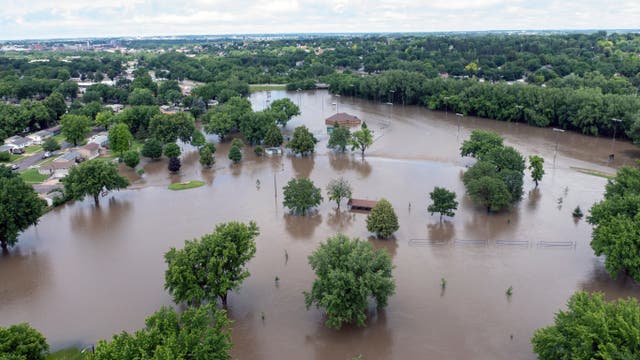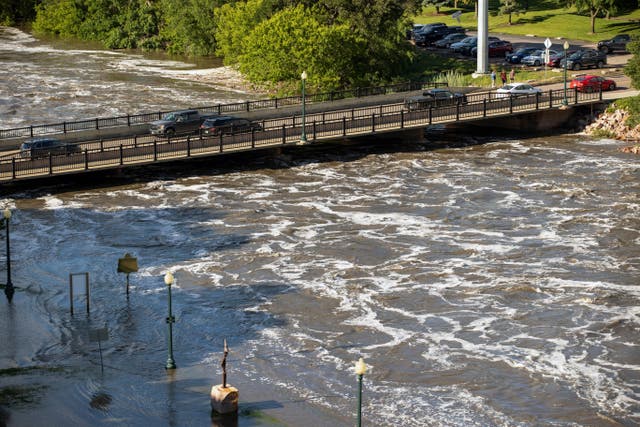Millions of Americans have sweated through a scorching weekend as temperatures soared across the US, while residents were rescued from floodwaters that forced evacuations across the Midwest.
One person was killed during flooding in South Dakota, the governor said.
From the mid-Atlantic to Maine, across the Great Lakes region, and throughout the West to California, public officials warned residents about the dangers of excessive heat and humidity.

At the borders of South Dakota, Iowa and Minnesota, floodwaters rose over several days. In north-west Iowa, 13 rivers flooded the area, said Eric Tigges of Clay County emergency management.
Entire neighbourhoods – and at least one entire town – were evacuated, and the Iowa town of Spencer imposed a curfew on Sunday for the second night in a row after flooding that surpassed the record set in 1953.
Mr Tiggs said: “When the flood gauge is underwater, it’s really high.”
Recent torrential rainfalls over N/NW Iowa, S Minnesota, SE South Dakota have lead to widespread areal and river floods on portions of the Upper Des Moines and Cedar River basins.
This includes near-record to record river crests forecast along the Upper Des Moines River. #iawx pic.twitter.com/PDdPDSVMNR
— NWS Des Moines (@NWSDesMoines) June 23, 2024
Governor Kim Reynolds declared a disaster for 21 counties in northern Iowa, including Sioux County. In drone video posted by the local sheriff, no streets were visible, just roofs and treetops poking above the water.
National Guard troops were helping with water rescues and transporting medication that was lost in flooding.
“Businesses are shuttered. Main streets have been impacted,” Ms Reynolds said. “Hospitals, nursing homes and other care facilities were evacuated. Cities are without power, and some are without drinkable water.”
National Weather Service meteorologist Donna Dubberke said parts of northern Nebraska, south-eastern South Dakota, southern Minnesota and north-west Iowa received eight times the typical average rainfall. More heavy rain was expected this week.

In South Dakota, governor Kristi Noem declared an emergency after severe flooding in the south-eastern part. Several major roads were closed.
Areas south of Sioux Falls, the state’s largest city, had an estimated 10 to 15in of rain over three days, National Weather Service hydrologist Kevin Low said.
At least one person died in the floods, Ms Noem said on Sunday, without providing details.
Several rivers, including the Big Sioux, James and Vermillion, were expected to peak sometime between Monday and Wednesday night, the governor said at a news conference.
Very warm conditions are expected through Thu, w/ 100+ degree highs over the interior. There is a risk of heat-related illnesses 🙴 an increased threat of grassfires. Slight chance of Tstms today 🙴 tonight. Use caution w/any source of fire or spark! #firewx #cawx pic.twitter.com/1zk7krKD0e
— NWS Los Angeles (@NWSLosAngeles) June 23, 2024
“I want to remind everybody to remember the power of water and the flow of water, and to stay away from flooded areas,” Ms Noem said.
“We’ve got a few days in front of us here that’ll be a little rough, but we’ll get through it.”
Emergency management officials in the small South Dakota community of Dakota Dunes on Sunday issued a voluntary evacuation order for the area’s roughly 4,000 residents.
Dakota Dunes is near the Nebraska and Iowa borders and is sandwiched between the Missouri and Big Sioux rivers, both of which are expected to crest in the coming days. Emergency management in Dakota Dunes warned residents that a mandatory evacuation could come quickly if flood barriers are breached.
Minor to moderate flooding was expected along the Missouri River, according to officials with the US Army Corps of Engineers.
Elsewhere, heat was the biggest worry.
Bruce Thoren, a National Weather Service meteorologist in Oklahoma, said: “It’s more important for people who are going to be outside to stay hydrated, because heat, humidity and low winds, even if you’re in good shape and not really acclimated to it, it could be a danger.
“It happens quickly.”
The cities of Washington, DC, Baltimore and Philadelphia all saw record heat on over the weekend.




Comments: Our rules
We want our comments to be a lively and valuable part of our community - a place where readers can debate and engage with the most important local issues. The ability to comment on our stories is a privilege, not a right, however, and that privilege may be withdrawn if it is abused or misused.
Please report any comments that break our rules.
Read the rules here